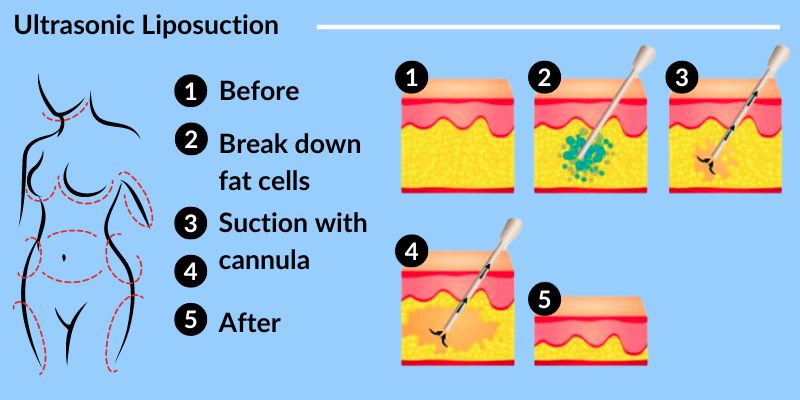
Ultrasonic Liposuction: An In-Depth Guide
Ultrasonic liposuction, also known as ultrasound-assisted liposuction (UAL), has gained popularity as a cutting-edge solution for removing unwanted fat and contouring the body. Unlike traditional liposuction methods, UAL uses ultrasonic waves to liquefy fat cells before their removal, offering a more precise approach to body sculpting. In this article, we will explore the procedure, its benefits, risks, recovery, and its effectiveness in comparison to traditional methods, providing a comprehensive overview of ultrasonic liposuction.
What is ultrasonic liposuction?
Ultrasonic liposuction is a cosmetic procedure that uses ultrasonic energy to break down fat cells, making them easier to remove from the body. The liquefied fat is then suctioned out using a cannula, a thin tube commonly used in liposuction procedures. This technique allows surgeons to target stubborn areas of fat that may not respond well to diet and exercise, including the abdomen, thighs, arms, and back.
The procedure can be performed internally, where a probe is inserted under the skin, or externally, where a paddle-like device is used on the skin's surface. The internal method is more commonly used due to its higher precision in fat removal.
How does ultrasonic liposuction work?
During the procedure, ultrasonic waves are emitted through a small rod inserted into the skin. These waves break down the walls of the fat cells, turning them into a liquid form. This process allows the fat to be more easily extracted via suction, resulting in a smoother, more even fat removal process compared to traditional liposuction.
In addition to fat removal, UAL promotes skin contraction and collagen production, which helps tighten the skin in treated areas. This makes it an appealing option for those who want both fat removal and skin tightening, without the need for multiple procedures.
Benefits of ultrasonic liposuction
Ultrasonic liposuction offers several advantages over traditional liposuction techniques, such as suction-assisted liposuction (SAL) and tumescent liposuction. The benefits of UAL include:
Precision Fat Removal: UAL allows for more precise targeting of fat, especially in fibrous areas that are resistant to other forms of liposuction.
Effective on Stubborn Areas: It can successfully address stubborn fat deposits, such as fat rolls or areas like the neck, chin, and knees.
Increased Skin Tightening: The procedure encourages skin contraction and collagen production, reducing the likelihood of loose skin after fat removal.
Less Surgeon Fatigue: Since UAL liquefies the fat before removal, it eases the strain on the surgeon, potentially leading to more consistent results.
Minimal Damage to Surrounding Tissue: The ultrasonic energy specifically targets fat cells, minimising the risk of damage to nearby blood vessels, nerves, and connective tissue.
Risks and considerations
While ultrasonic liposuction offers numerous benefits, it is not without risks. As with any surgical procedure, there are potential side effects and complications. Some of the risks associated with UAL include:
Scarring: There is a higher risk of scarring with UAL compared to traditional liposuction methods, as the ultrasound waves can sometimes damage surrounding skin and tissue.
Seromas: Fluid-filled pockets known as seromas can develop in the treated areas. While these typically resolve on their own, they can occasionally require drainage.
Nerve Damage: There is a small risk of nerve damage, which could lead to temporary or permanent numbness in the treated area.
Infection: As with any surgical procedure, there is a risk of infection at the incision sites.
It is essential for patients to have a thorough consultation with their surgeon to understand the risks and to ensure that they are good candidates for the procedure. Those with certain medical conditions, such as diabetes, heart disease, or weakened immune systems, may not be suitable candidates for UAL.
Ultrasonic liposuction vs traditional liposuction
One of the most common questions patients ask is how ultrasonic liposuction compares to traditional methods like SAL and tumescent liposuction. The key differences lie in the technology used and the precision of fat removal.
- Traditional Liposuction: SAL involves the manual suction of fat cells through a cannula. While effective, it can sometimes lead to uneven fat removal and is not as effective in areas with dense or fibrous fat.
- Ultrasonic Liposuction: UAL's ultrasonic waves break down fat cells more efficiently, making it ideal for treating fibrous areas. It also promotes skin tightening, which traditional liposuction does not inherently do.
Ultimately, the choice between UAL and traditional methods depends on the patient's specific goals, the area being treated, and the surgeon's expertise.
Recovery and results
The recovery process for ultrasonic liposuction is relatively brief. Most patients can return home the same day, as UAL is typically performed as an outpatient procedure. However, it is essential to follow the surgeon’s post-operative instructions carefully to ensure a smooth recovery. Common post-surgery advice includes:
- Rest and Limited Activity: Patients are advised to rest for a few days and avoid strenuous activity for at least two weeks. Light exercise, such as walking, can help promote blood flow and prevent complications like blood clots.
- Compression Garments: Wearing compression garments can help reduce swelling and support the treated area during the healing process.
- Hydration and Diet: Drinking plenty of water and following a healthy, low-fat diet can help the body eliminate the remaining fat cells more efficiently.
It is important to note that results from UAL are not immediate. Swelling and mild bruising are common and can take several weeks to subside. The final results may take up to six months to fully manifest, but many patients begin noticing improvements within a few weeks.
Is ultrasonic liposuction effective?
Numerous studies and patient testimonials suggest that ultrasonic liposuction is an effective method for fat removal and body contouring. One study reported that 80% of patients were satisfied with their results following the procedure. However, maintaining the results requires commitment to a healthy lifestyle. In fact, up to 35% of patients in the same study experienced weight gain within the first year post-surgery, highlighting the importance of dietary and exercise habits after the procedure.
While UAL is highly effective for fat removal, it is not a weight loss solution. It is best suited for individuals who are already close to their ideal body weight but have stubborn fat areas that do not respond to diet or exercise.
Conclusion
Ultrasonic liposuction is a modern, effective solution for removing stubborn fat and contouring the body. With its precision, skin-tightening benefits, and relatively short recovery time, UAL has become a popular alternative to traditional liposuction methods. However, it is crucial to approach the procedure with realistic expectations, understanding that it is not a substitute for weight loss and requires a healthy lifestyle to maintain the results. Consulting with a qualified surgeon is essential to determine whether UAL is the right choice for your body contouring goals.
Click here for what you wonder about Vaser liposuction.

